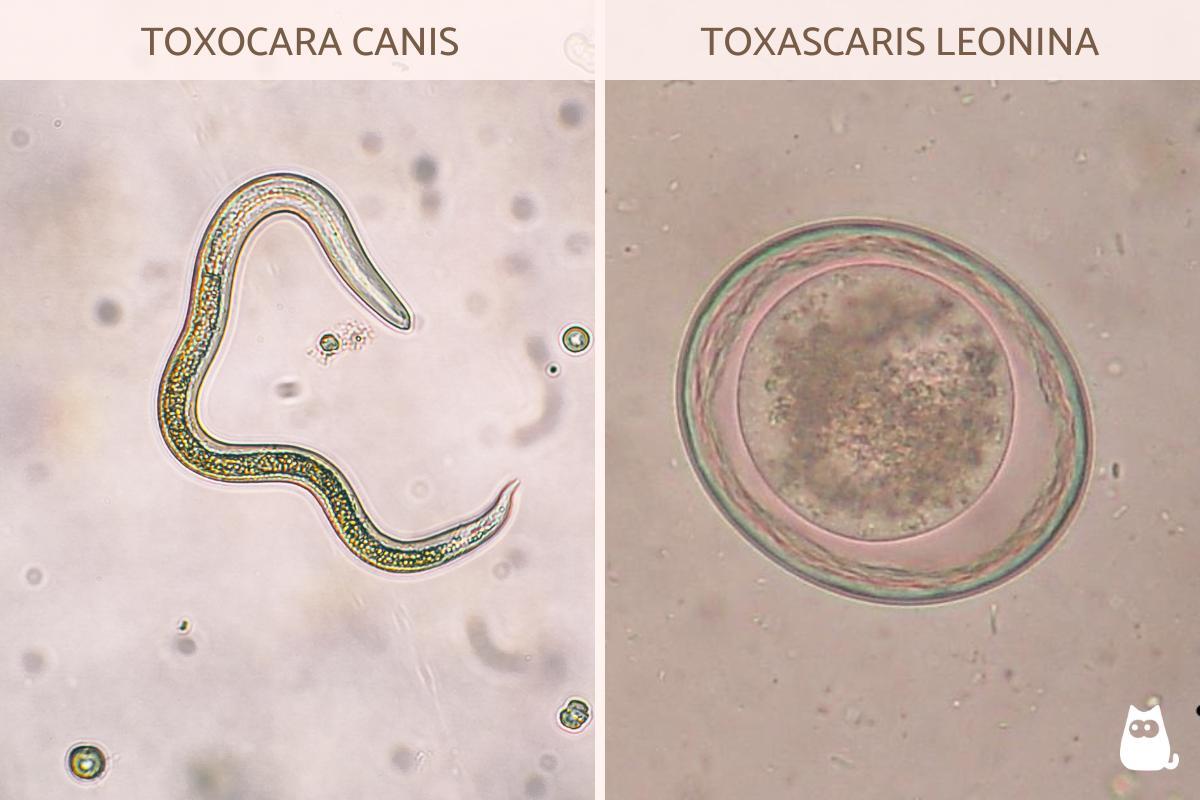Roundworm in Dogs - Toxocara and Toxascaris Infections



See files for Dogs
Toxocariasis is a parasitic disease caused by roundworms which can affect dogs and cats. In dogs, the roundworm species capable of causing infection are Toxocara canis and Toxascaris leonina. Although they are similar parasites, they behave differently in the body of dogs, which is why they cause slightly different diseases. They cause toxocariasis and toxascariasis, respectively. The scientific literature does not often make a distinction and may refer to infections by Toxascaris leonina as toxocariasis.
Both these diseases are commonly known as roundworm in dogs, although there are different types of roundworm parasites which can affect canines. At AnimalWised, we look at Toxocara canis roundworm in dogs, specifically its symptoms and treatment, as well as how we can avoid transmission to our dog.
Types of roundworm in dogs
All roundworms in dogs are types of nematodes, so called because they are part of the phylum Nematoda. Toxocara canis and Toxascaris leonina are from the family Ascarididae, often referred to as ascarids. Learn more about Toxocara canis in dogs with our related article.
There are other genera which contain roundworms which can affect animals. They include Ascaris, Baylisascaris, Hexametra and Parascaris. Of the these genera, Ascaris lumbricoides is most commonly known to affect dogs, especially puppies. The two we look into more detail are
- Toxocara canis
- Toxascaris leonina
Toxocara canis
It is a large intestinal nematode and one of the most common intestinal parasites in dogs. Adults measure between 4-6" (10-15 cm). They can infect dogs of any age, although the disease is most serious in puppies due to their relative vulnerability.
Infections of the adult roundworms are located in the small intestine where they lay eggs that are later eliminated with feces. Once in the environment, the eggs become a source of infection for other dogs. After ingesting the eggs, they hatch in the small intestine, resulting in the release of larvae. Once the Toxocara larvae are released, they can perform four types of migrations in the dog's body:
- Entero-pneumo-enteric migration: the Toxocara canis larvae penetrate through the intestinal wall, migrate to the lungs and finally return to the intestine. It is there where the cycle is completed as they become adults. This migration occurs in dogs that become infected at less than 5 weeks of age.
- Entero-pneumo-somatic migration: the migration begins the same as the previous type, from the intestine to the lungs. The difference is that the larvae then migrate throughout the organism from the lungs. They infect different tissues, including the muscles, liver, kidney, uterus and mammary glands, among others. This migration occurs in dogs that become infected after more than 5 weeks of age.
- Hepato-pneumo-enteric migration: this is the migration that occurs in puppies when they are infected transplacentally, i.e. while still in the mother's uterus. The larvae stationed in the mother's tissues are passed to the pups through the maternal-fetal circulation. Once in the fetus, they migrate to the liver, from there to the lungs, and finally to the intestine.
- Entero-enteric cycle: it is not really a migration in itself, since the parasites are only present in the intestine. This type of migration occurs when dogs are infected by ingestion of paratenic hosts (such as rodents, birds, or invertebrates) or through the lactogenic route (in puppies that consume milk from infected mothers).
Toxascaris leonina
It is also a type of intestinal nematode, although the adult worms are slightly smaller than those of Toxocara. They usually measure between 1.1-4" (3-10 cm). There is no organic migration of the parasite. The cycle takes place exclusively in the intestine which is known as the entero-enteric cycle. The global infection rates of dogs is around 2.9%, although this may be as much as 7.0% in the Eastern Mediterranean which has the highest population[1].

Can roundworm in dogs be transmitted to people?
Tthe larvae of Toxocara canis can infest humans. They can infect people and cause a disease known as visceral larva migrans. This infectious disease is characterized by the appearance of granulomatous lesions in different organs, mainly in the liver, lungs, brain, and occasionally in the eye. It is associated with the appearance of symptoms such as intermittent fever, persistent cough, weight loss and loss of appetite.
It mainly affects children under 5 years of age. They are often infected by eating soil contaminated with eggs of these parasites. However, it is a global public health problem and the infection can occur in people of any age.
The prevention of this dog disease transmissible to humans is based on a few simple measures:
- Keep dogs away from parks and children's playgrounds.
- Carry out a correct deworming protocol in dogs from birth.
- Avoid close contact with dogs that have not undergone proper parasitological control.
Causes of roundworms in dogs
The cause of toxocariasis in dogs is infestation by the Toxocara canis roundworm. However, the routes of transmission can vary. Dogs are most commonly infested by Toxocara canis by the following 4 main routes:
- Direct ingestion of eggs: eating soil, feces and other matter present in the dog's environment which contains embryonated eggs. Learn more about coprophagia in dogs with our article on why dogs eat poop?
- Ingestion of paratenic hosts: dogs may eat rodents, birds or invertebrates that have larvae infesting their tissues.
- Transplacental route: parasites are transmitted to fetuses while in the maternal uterus. In this case, the puppies are born infected.
- Lactogenic pathway: the roundworms are transmitted through milk from the mother to puppies as they suckle on their teats.
In the case of Toxascaris leonina, the infection can only occur via two routes:
- Ingestion of embryonated eggs
- Ingestion of paratenic hosts
In the case of Toxascaris, this means transmission cannot occur directly from the mother to her puppies.
Symptoms of roundworm in dogs
Now we know how Toxocara canis is transmitted in dogs, we can look at the resultant symptoms in the dog's organism. Said symptoms can vary according to different factors such as the extent of the infection, the state of health of the dog and the route of migration within the body.
In general, dogs with roundworms often show the following symptoms:
- Stunted growth
- Deteriorated appearance
- Bulging belly
- Vomiting
- Diarrhea
Both in Toxocara and in Toxascaris infections, the most common symptom to observe vomiting and diarrhea in dogs. This is a consequence of the presence of the parasite in the stomach and intestine. Periodically, adult parasites are shed with feces and with vomit, although the latter is less common. It is for this reason you can see roundworms in a dog's poop.
In the specific case of Toxocara canis, it is common for pneumonia to develop during the lung migration phase. This is accompanied by coughing, nasal discharge and increased respiratory rate.
Death can occur both in the pulmonary phase and in the enteric phase. This is due to intestinal rupture and consequent peritonitis. In general, infections tend to be more serious when animals are raised in facilities with poor hygiene and also in those individuals with a compromised immunological or nutritional status.
You can see an example of the Toxocara canis round worm in the photo below. This is when the nematode is in its adult stage.
Learn about more general infestations with our article on the different types of parasites in dogs and their symptoms.

Diagnosis of roundworms in dogs
The presumptive diagnosis of toxocariasis in dogs is usually made based on the symptoms. For its confirmation, it is necessary to perform a stool analysis.
Carrying out a stool analysis will allow detecting the presence of ascarid eggs and identifying the specific species that causes the infection:
- Toxocara eggs: are spherical, dark and have a thick shell that often has small indentations.
- Toxascaris eggs: are slightly ovoid, have a lighter coloration and have a smooth shell with a kind of braid on the inside.

Treatment of roundworm in dogs
Treatment of roundworm requires the elimination of Toxocara canis and Toxascaris leonina roundworms from the animal's organism. The deworming protocol against roundworms will depend on the age and physiological state of the animals:
- Puppies: must be dewormed every fortnight, starting at two weeks of age. This fortnightly treatment should be repeated until 2 weeks after weaning. After that, it must be dewormed monthly until 6 months of age.
- Pregnant bitches: should be treated with macrocyclic lactones on days 40 and 55 of gestation, or with fenbendazole from day 40 of gestation until the second day postpartum. Learn more with our guide to Panacur for dogs.
- Lactating bitches: should be treated every two weeks, simultaneously with their puppies.
- Adult dogs: it is best to assess the risk of each animal individually, in order to establish the most appropriate deworming regimen. The general recommendation is to carry out treatments at least 4 times a year, although in risk situations (such as dogs that live with children) it is advisable to perform monthly deworming. As an alternative to routine deworming, periodic stool tests can be performed and treated if the test is positive.
If you see roundworms in your dog's poop, but do not see any other symptoms, you will still need to deworm the dog. If an infestation is left to continue, it can be fatal. This is especially the case when roundworms have migrated to the tissues of vital organs.
This article is purely informative. AnimalWised does not have the authority to prescribe any veterinary treatment or create a diagnosis. We invite you to take your pet to the veterinarian if they are suffering from any condition or pain.
If you want to read similar articles to Roundworm in Dogs - Toxocara and Toxascaris Infections, we recommend you visit our Parasitic diseases category.
1. Rostami, A., Riahi, S. M., Fallah Omrani, V., Wang, T., Hofmann, A., Mirzapour, A., Foroutan, M., Fakhri, Y., Macpherson, C. N. L., & Gasser, R. B. (2020). Global Prevalence Estimates of Toxascaris leonina Infection in Dogs and Cats. Pathogens (Basel, Switzerland), 9(6), 503.
https://doi.org/10.3390/pathogens9060503
- European Scientific Counsel Companion Animal Parasites. (2021). Guide nº1. Control of worms in dogs and cats.







